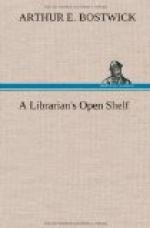The reason why there were no locomotives in ancient Rome is that in those days the locomotive had not yet been invented, and when we say this we refer not to the materials, which the Romans had in abundance, but to the idea or plan of the locomotive. So it is with the whole material world about us. The things that result, not from man’s activities, but from the operations of nature, are no exceptions; for, if we are Christians, we believe that the idea or plan of a man, or a horse, or a tree, was in the mind of the great architect, the great machinist, before the world began, and that this idea is the important thing about each.
A man, a house, an engine—these are ideas that lead to things that we can feel, and see and hear. But there are other ideas that have nothing of the kind to correspond to them—I mean such ideas as charity, manliness, religion and patriotism—what sometimes are called abstract qualities. These are real things and their ideas are even more important than the others, but we cannot see nor feel them.
Now, man likes to use his senses, and it is for this reason that he is fond of using for these abstract ideas, symbols that he can see and feel. We of St. Louis should appreciate this to the full just now, for we have just set before the world the greatest assemblage of symbolic images and acts, portraying our pride in the past and our hope and confidence for the future, that any city on this earth ever has been privileged to present or to witness.[10] Whether we were actors or spectators; whether we camped with the Indians, marched with De Soto or La Salle and felled the forests of early St. Louis with Laclede and Chouteau, or whether we were part of that great host on the hillside, we can say no longer that we do not understand the importance of the idea, or the value and cogency of the visible symbols that fix it in the memory and grip it to the heart.
[10] The Pageant and Masque of St. Louis, 1915.
The Church of Christ always has understood and used this property of the visible and tangible symbol to enforce the claims of the abstract idea.
We revere the cross, not because there is anything in its shape or substance to make us venerate it, but because it is the symbol of the Christian religion—of all that it has done for the world in the past and all that it may do in the future. That is why we love and honor the flag—not because it is a piece of cloth bearing certain figures and colors, but because it is to us the symbol of all that our country has meant to our fathers; all it means to us and all that it may mean to our children, generation after generation.




